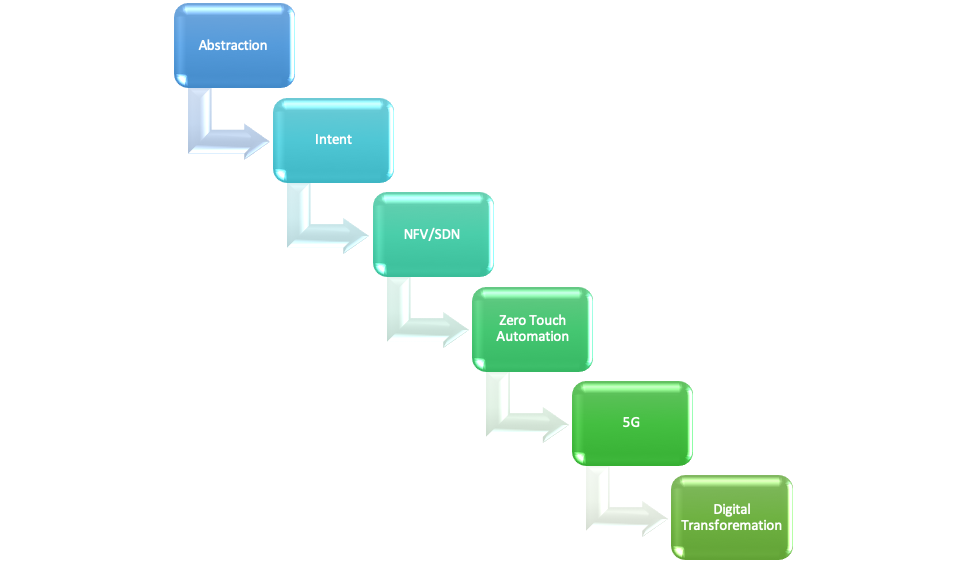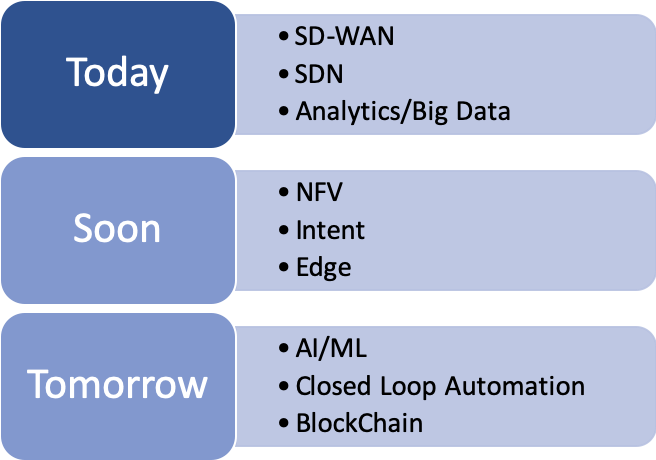
Introduction
Madrid, a city steeped in tradition dating back to the ninth century, hosted the Layer123 Zero Touch Automation event from March 26-28. This was the second annual event and, like many of the spring events, saw attendance dip compared to last year. The intimate setting encouraged candid participation among motivated attendees, especially from the operators who shared their vision and experiences. Strong participation by forward-thinking operators was driven by a sincere commitment to automation, which is essential to their transformation.
Enabling Transformation
Operators including BT, Verizon, PCCW Global, and host operator Telefonica, all resonated with the high-level goal of digital transformation, even though their approach, objectives, and progress varied widely.
One common theme was that 2019 IS the year of 5G, which justifies operator transformation. Automation based on NFV/SDN is the enabler for 5G, which is in turned enabled by Intent. Figure 1 summarizes the chain of enablers discussed.
Intent, also alluded to as “declarative” networking, allows network users to specify the desired outcome — “The What” independent of the underlying implementation “The How”.
The notion of Intent is not new, but it is predicated on meticulously selecting the appropriate level of abstraction. Open source orchestrators like ONAP and OSM, standards bodies defining northbound APIs including the MEF Lifecycle Services Orchestration (LSO) reference architecture, and many major solution vendors have devoted significant effort to modeling and abstraction to implement Intent-based networking.

Real-world Progress
At last year’s event, orchestration and automation garnered a great deal of attention, especially as ONAP turned one year old and OSM turned two. Operators were receptive to open source orchestration as the basis for their automation strategies.
After experimentation with open source and proprietary platforms over the past year, operators at this year’s conference reported a more conservative approach when it comes to open source adoption.
Open source platforms take years to evolve into deployable solutions, especially considering the complexity of orchestration. For instance, Linux Foundation Networking’s OpenDaylight, the most successful multi-vendor open source networking platform, did not begin to thrive until after significant re-architecture followed by renewed focus on deployment and operations. This resulted in a much more stable code base, motivating multiple commercial distributions with corresponding service, and support offerings as well.
As a result, operators are working with their traditional solution providers, including systems integrators, to develop and deploy proprietary platforms, along with open source components.
Over the last 12-18 months, automation hype has remained strong but is clearly sliding into Gartner’s Trough of Disillusionment. Now that operators and their development partners have gained knowledge through experimentation with the key technologies, the automation technology landscape is becoming more focused. Figure 2 offers a snapshot of the automation technologies as of 2019. Particularly interesting were a glimpse of AI and blockchain applications for telecommunications.

Focus on Operationalization
The ETSI Zero touch network and Service Management (ZSM) Industry Specification Group (ISG) presented a workshop on their efforts to shift the focus from technology to operations. ZSM’s goal is to provide a “future-proof, horizontal and vertical end-to-end operable framework” initially focusing on 5G use cases (not surprisingly).
However, ZSM represents an open networking industry group in the spirit of the original Open Networking Foundation and ETSI NFV ISG, which are not quite standards bodies nor open source projects but another type of entity influenced by both. By focusing on end-to-end management, and pragmatic implementation through the Proof of Concept program, modelled after the highly successful ETSI NFV PoC program, ZSM should achieve faster uptake.
Like other related ETSI activities, ZSM is an ISG which allows for participation by non-ETSI members. While this is helpful to gain critical mass fast, ISG “membership” — as it is referred to in ETSI projects — is a bit misleading, as organizations can contribute or observe at will without significant skin in the game.
Unlike the open orchestration projects, ZSM addresses end-to-end and interdomain issues up front, with an explicit focus on automation. The initial use cases include 5G Network Slicing management and interdomain management. ZSM expects to produce framework specifications that inherently enable operators to tailor them to their individual environments.
Another operational area eliciting growing consensus is the need for federation. Hierarchical Orchestrator of Orchestrator deployment is constrained to a single operator domain but is infeasible for end-to-end services. Most typical operators partner with dozens, if not hundreds, of operator partners. And as a result, federation across these partners is necessary for success. Multiple operators at the show, led by PCCW Global, concurred that a federated approach is critical. Still another area of concern is that the testing/methodology must also evolve to address the needs of the automated service delivery lifecycle, which in itself will require a significant effort to define and coordinate across all parties in the lifecycle.
But Challenges Remain
The road to automation is not without risks or stumbling blocks. Among the key concerns expressed are:
- VNF management: At the top of the list. Addressing VNF Lifecycle Management (LCM) is challenging enough, especially with ever-increasing VNFs from virtually every vendor, but VNF LCM remains the simplest challenge. Consolidating LCM along with FCAPS and change management has proven to be intractable. Few vendors have managed to overcome the most significant challenge, but ETSI and ONAP, among other groups, are focusing in this area. Telefonica shared encouraging signs on their Unica initiative which will serve as an existence proof to spawn further industry innovation.
- Managing complexity: Zero-touch automation may simplify operations for the user, but at the expense of significant underlying complexity. Lack of a common information model — even after recognizing the importance, years of work, and unprecedented industry coordination haven’t moved the needle much. This has resulted in converters, adapters, etc. in order to integrate building blocks sourced from diverse suppliers.
- New vendor lock-in? The move to openness, and disaggregation in particular, is shifting the discussion on lock-in from products to services. Operators recognize the long-term liabilities of being locked into not only their equipment/software vendors but also, in the open world, systems integrators who ultimately assume responsibility for creating solutions from the components.
- Interdomain: MEF, ZSM, and other groups are stepping up their activities to not only propose end-to-end frameworks but also the underlying technology support to enable end-to-end services that span multiple domains and operators.
- Organization Impact: Finally, the ever-present challenge to migrate the organization towards a culture of openness. Fittingly, the closing keynote did address “The Cultural Impact of Open Networking”.
Reasons for Optimism
Upon reflecting on the presentations and discussions, there was healthy skepticism yet steadfast resolve demonstrated by operators striving to accelerate their own digital transformation. Positive outcomes include:
- Orchestration deployments: Orchestration vendors alluded to a growing number of customers, no doubt many driven by 5G, with more tenders expected in 2019 and 2020.
- Harmonization beginning: More and more standards bodies and open source communities are engaging in more focused activities, which is essential for NFV and automation.
- Open Source adoption: Even though open source platforms suffered a setback, operators appear to be resolved to adopt components where appropriate and adapt their organizations to address open source software.
- Open APIs emerging: Open APIs were not even on the radar two years ago but are rapidly gaining momentum. Some believe APIs are the answer to enabling multivendor automation. Telstra shared their vision based on standard, open APIs to assert their Network as a Service (NaaS) architecture.
Progress on many fronts continues to instill confidence in operators striving to expedite their individual journeys towards automation. The ZTA was indicative of the state of automation, with encouraging signs and major challenges to overcome. The increased commercial activity is the engine that drives change, and by next year’s conference, 5G will result in even greater attention to operationalizing NFV and SDN.
Acknowledgement
Many thanks to Johanne Mayer for her insights and feedback, which are reflected in this Blog.
Photo source: Layer123. 2019 Zero Touch Automation Congress. March 26-28, 2019. Madrid, Spain.
